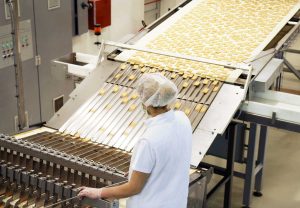4 telltale signs that it’s time to replace processing belts (and a tip for stretching yours further)

You’re probably all too aware of the high cost of belt replacement. Processing on the affected line comes to a halt, usually for 1–4 hours. With all costs factored in, it’s a $10,000–$100,000 undertaking depending on the size of the facility.
Suffice it to say that belt replacement is one task you want to put off as long as possible. However, in an environment that demands optimum hygiene, such as food processing, you may not have that luxury. The condition of conveyor belts directly impacts food safety. Here are 4 indicators that signal it’s time for a change.
1. Cracks and scars
Look closely at belt surfaces and edges. If you see cracks and/or deep longitudinal scarring, you may already be on the fast track to contamination. The tiniest break in the surface caused by scraping, cleaning or other agents becomes a nook for bacteria and fungi that will be impossible to remove even with normal sanitation processes.
2. Discoloration
Another sign that a belt needs to be replaced: Discoloration. You may not care if a belt turns purple as long as it does the job ⏤ but what the belt is really telling you is that its surface properties are wearing down due to age and frequent cleaning. As material deteriorates, particles could end up in your products.
3. Chemical effects
Learn how chemistry affects belt material. Acidic products can have a negative impact over time. Using the wrong cleaners and sanitizers can lead to staining, flexing and abrasions ⏤ all potential signs of degradation and potential failure.
4. Swab tests
Routine swab tests should be a part of the cleaning and maintenance protocol to ensure that belts are well sanitized. If a test reveals anything less than perfection, it may be wise to go ahead and replace the belt for safety’s sake.
Here’s a pro tip to prolong your belt life:
You can reduce intervals of belt replacement and still maintain the highest sanitation standards in food processing. The Habasit Cleandrive lug drive is the most hygienic and reliable food-safe bet on the market ⏤ and also happens to be engineered for longer belt life. For example:
- The belt surface contains a special polyurethane formula that promotes exceptional resistance to microbes and hydrolysis. This not only reduces contamination but also acts like an armor against organic degradation, discoloration and harsh chemical effects.
- Because the lug drive is extruded from a single, premium TPU material, the surface is extremely smooth and holds up against scraping, divots and other damaging wear and tear. This promotes longer, healthier belt life.
- Traditional unreinforced monolithic belts tend to experience a detectable degree of initial elongation and continuous stretch. That’s not an issue with Habasit Cleandrive lug drive: Aramid cords reinforce the belt and reduce the need to re-tension or shorten the belt. Long-term tensile tests showed that Habasit Cleandrive limits elongation to less than 1%.
Stretch your belt life – and your maintenance dollar
Compared to competing belt fabrics, Habasit Cleandrive has been shown to deliver 600% longer belt life, with savings in the tens of thousands of dollars depending on the application. It has also proven to last 50% longer than competing monolithic belts. Consider the amount of downtime, labor and the materials in your own organization. Habasit Cleandrive lug drive might just be the answer for you. Learn more about it here.
Join Bernd Roser & Niels Vindsmark оn a webinar entitled Factoring belting and conveyor components into your food safety strategy by Habasit on 15th of April at 3PM London/10AM New York.
